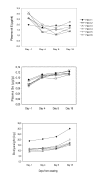Vitamin E and selenium plasma concentrations in weanling pigs under field conditions in Norwegian pig herds
- PMID: 17201915
- PMCID: PMC1779789
- DOI: 10.1186/1751-0147-49-1
Vitamin E and selenium plasma concentrations in weanling pigs under field conditions in Norwegian pig herds
Abstract
Background: The status of alpha-tocopherol (vit E) and selenium (Se) has been shown to influence disease resistance in pigs, and may be important for the health of weanling pigs.
Methods: Plasma levels of both vit E and Se were followed in weanling pigs under field conditions in six Norwegian pig herds. Plasma vit E and Se were measured in 3 sows from each herd and 4 piglets in the litter of each sow at the day before weaning (day -1); and in the same piglets at days 4, 8 and 18 after weaning.
Results: Mean plasma vit E was 4.0 microg/ml in the sows and 2.6 microg/ml in the piglets at day -1, fell to 1.6 microg/ml in the weanling pigs at day 4, and remained low. Mean plasma Se was 0.22 microg/g in the sows and 0.08 microg/g in the piglets at day -1, rose to 0.10 microg/g in the weanlings at day 4, and continued rising.
Conclusion: The results suggest that vit E and Se supplementation to piglets and weanling pigs in Norway may still be suboptimal, but that levels of the two nutrients partially compensate for each other in the weaning period.
Figures


Similar articles
-
An evaluation of natural (RRR-alpha-tocopheryl acetate) and synthetic (all-rac-alpha-tocopheryl acetate) vitamin E fortification in the diet or drinking water of weanling pigs.J Anim Sci. 2008 Mar;86(3):584-91. doi: 10.2527/jas.2007-0377. Epub 2007 Dec 21. J Anim Sci. 2008. PMID: 18156353
-
Effects of oral micellized natural vitamin E (D-α-tocopherol) v. synthetic vitamin E (DL-α-tocopherol) in feed on α-tocopherol levels, stereoisomer distribution, oxidative stress and the immune response in piglets.Animal. 2014 Mar;8(3):410-9. doi: 10.1017/S1751731113002401. Animal. 2014. PMID: 24534689
-
Effects of water supplementation with selenium and vitamin E on growth performance and blood selenium and serum vitamin E concentrations in weanling pigs.J Am Vet Med Assoc. 1997 Oct 15;211(8):1039-42. J Am Vet Med Assoc. 1997. PMID: 9343551 Clinical Trial.
-
Effect of supplementing sows' feed with alpha-tocopherol acetate and vitamin C on transfer of alpha-tocopherol to piglet tissues, colostrum, and milk: aspects of immune status of piglets.Res Vet Sci. 2008 Aug;85(1):92-100. doi: 10.1016/j.rvsc.2007.08.007. Epub 2007 Sep 27. Res Vet Sci. 2008. PMID: 17904172 Clinical Trial.
-
Control of pig reproduction in a breeding programme.J Reprod Fertil Suppl. 1985;33:211-28. J Reprod Fertil Suppl. 1985. PMID: 3910826 Review.
Cited by
-
Effect of dietary selenium and omega-3 fatty acids on muscle composition and quality in broilers.Lipids Health Dis. 2007 Oct 29;6:29. doi: 10.1186/1476-511X-6-29. Lipids Health Dis. 2007. PMID: 17967172 Free PMC article.
-
Mixed supplementation of dietary inorganic and organic selenium modulated systemic health parameters and fecal microbiota in weaned pigs.Front Vet Sci. 2025 Feb 14;12:1531336. doi: 10.3389/fvets.2025.1531336. eCollection 2025. Front Vet Sci. 2025. PMID: 40027358 Free PMC article.
-
Antiviral Effect of Selenomethionine on Porcine Deltacoronavirus in Pig Kidney Epithelial Cells.Front Microbiol. 2022 Feb 15;13:846747. doi: 10.3389/fmicb.2022.846747. eCollection 2022. Front Microbiol. 2022. PMID: 35242124 Free PMC article.
-
Partial Replacement of Synthetic Vitamin E by Polyphenols in Post-Weaning Piglets.Antioxidants (Basel). 2023 Sep 12;12(9):1752. doi: 10.3390/antiox12091752. Antioxidants (Basel). 2023. PMID: 37760055 Free PMC article.
-
Effects of age and weaning conditions on blood indicators of oxidative status in pigs.PLoS One. 2017 May 24;12(5):e0178487. doi: 10.1371/journal.pone.0178487. eCollection 2017. PLoS One. 2017. PMID: 28542567 Free PMC article.
References
-
- Chung YK, Mahan DC, Lepine AJ. Efficacy of dietary D-α-tocopherol and DL-α-tocopheryl acetate for weanling pigs. J Anim Sci. 1992;70:2485–2492. - PubMed
-
- Håkansson J, Hakkarainen J, Lundeheim N. Variation in vitamin E, glutathione perroxidase and retinol concentrations in blood plasma of primiparous sows and their piglets, and in vitamin E, selenium and retinol contents in sows' milk. Acta Agric Scand , Sect A, Anim Sci. 2001;51:224–234. doi: 10.1080/09064700152717209. - DOI
-
- Meyer WR, Mahan DC, Moxon AL. Value of dietary selenium and vitamin E for weanling swine as measured by performance and tissue selenium and glutathione peroxidase activities. J Anim Sci. 1981;52:302–311.
-
- Teige J, Tollersrud S, Lund A, Larsen HJ. Swine dysentery: the influence of dietary vitamin E and selenium on the clinical and pathological effects of Treponema hyodysenteriae infection in pigs. Res Vet Sci. 1982;32:95–100. - PubMed
-
- Wuryastuti H, Stowe HD, Bull RW, Miller ER. Effects of vitamin E and selenium on immune responses of peripheral blood, colostrum, and milk leukocytes of sows. J Anim Sci. 1993;71:2464–2472. - PubMed
Publication types
MeSH terms
Substances
LinkOut - more resources
Full Text Sources
Medical

